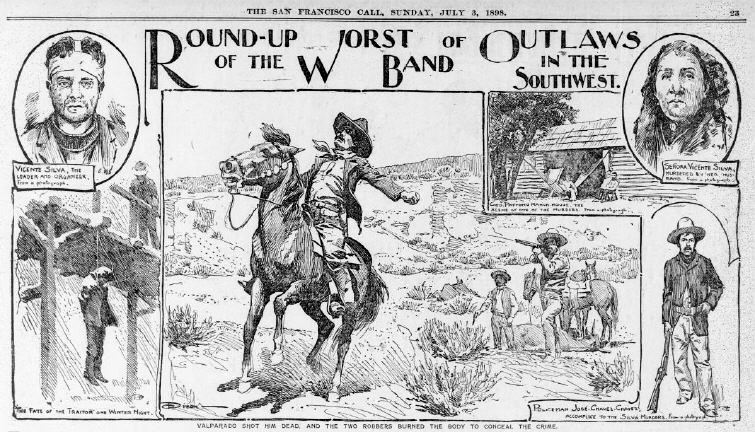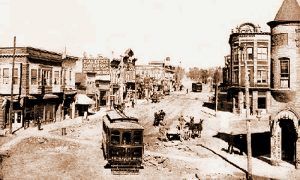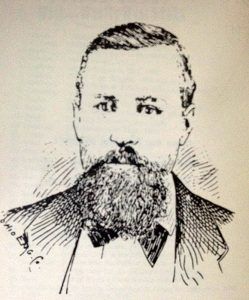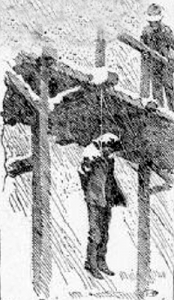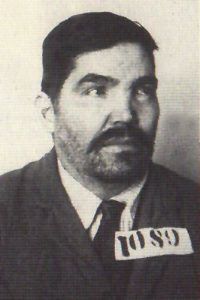Silva’s White Caps were a vicious outlaw gang that operated in Las Vegas, New Mexico, from about 1879 to 1893. Also called La Sociedad de Bandidos and Forty Bandits, they were a mafia-like organization that Vicente Silva led.
Silva was a profitable businessman in Las Vegas. Through fence-cutting, arson, and physical assault, the gang sought to drive settlers from lands that had once been common pasture. Often meeting in Silva’s Imperial Saloon on Moreno Street, the gang also committed various crimes and gained the reputation as one of the meanest and cruelest gangs ever assembled in New Mexico.
When Colonel W. A. Adams and his two sons were found dead with bullets in their heads and stab wounds in their chests at their sheep ranch home about 30 miles south of Los Cerrillos; it was generally believed that the Pueblo Indians had revenged themselves on the white men. Afterward, of the terrible murders reached Las Vegas, Vicente Silva went about declaring that he would be one of a committee to go and bring the Indians to justice. Several years later, it would be found that Colonel Adams had discovered who was robbing him and his fellow sheep raisers and was about to expose the robbers as the Silva Gang.
The business of crime went well for Silva and his men for several years. Vincente was a gracious and agreeable host at his saloon and was a charitable man in the community, giving money to the church, the Orphans’ Home, and to the poor old people about town.
In the meantime, cattle, mules, and sheep continued to go missing. There were mysterious disappearances of miners and cowboys carrying money, especially those who had no interested relatives in the Territory. Pedro Vejar was seen going to Las Vegas one evening in May 1890, but he was never seen again after he had sold his wool for $200. After Antonio Vasquez drew two months’ pay from the Santa Fe Railroad Company one afternoon, he was last seen at Silva’s saloon a few hours later, partially drunk. His cousin and sister searched diligently for him, but not a clue could ever be had to his fate. Finally, Ramon Oberro disappeared in the winter of 1891-92 along with $300 from his sale of mules.
In July 1891, over 70 cattle were reported stolen, and three area post offices were robbed. People were shocked when the news came in the summer of 1891 that the ranch home of George E. Payson in San Bernalillo County had been found broken into and his remains lay badly decomposed on the floor, where the young man had fallen in a desperate encounter with unknown murderers. The house had been robbed of the money and valuables Payson was believed to have had there. In addition, several heads of cattle had been killed and skinned on the ranch.
Several area Sheriffs and their deputies scoured the country looking for the thieves and killers, and the ranchmen banded themselves together to protect their property. But still, the thefts, killings, and disappearances continued. The Indians were given a good deal of credit for the crimes, but no evidence could ever be found against any of them.
However, things would change In October 1892 when Refugio Esquibel, the wealthiest ranchman in San Miguel County, found four of his best-bred horses missing from the range. He went hunting over the mountains for the horses with his ranchmen and came upon them in at a small rock corral at Silva’s isolated ranch. He immediately notified the Sheriff and gang member Patricio Maes, who was arrested at the corral. Fearful that he might be lynched, he secretly told what he knew to the authorities. He was then let go for a week, at which time he was to get more accurate information for the police officers.
Vincente Silva soon found out that Maes was about to tell all and called a nighttime meeting at his saloon with all the gang members. At a “mock trial,” the gang members judged Maes guilty, and he was hanged in the middle of a snowstorm on a bridge over Gallinas Creek on October 22, 1892. When his body was found, a Coroner’s jury decided that he had been lynched for an unknown crime.
Afterward, events moved swiftly, and Silva fled on October 26th to a secret hiding place in the mountains near Los Alamos, New Mexico. During his absence, he was indicted for horse and cattle stealing on November 7, 1892, and the Territorial Governor soon offered $1,000 for his capture. Suspecting that his brother-in-law, Gabriel Sandoval, was going to inform on the gang about the lynching of Maes, he ordered him killed. Three crooked lawmen and gang members, Jose Chavez y Chavez, Eugenio Alarid, and Julian Trujillo, shot and killed Sandoval in February 1893, and his body mysteriously disappeared.
Afterward, Silva’s wife began to ask numerous questions about her brother’s questionable disappearance, and Silva decided that she too had to be killed. He then ordered his men to dig her a grave. However, as the men dug, their discussion turned lethal, as they were dissatisfied with the paltry $10 payment and decided that Silva was out of control. When Silva appeared with his wife’s body, the men robbed and murdered him, burying his body along with his wife’s. This officially ended the reign of Silva’s White Caps.
In March 1893, the lawmen of San Miguel and Santa Fe Counties had obtained an abundance of evidence as to the men who composed Vicente Silva’s gang. Twenty arrests were made in a few weeks, and several men were brought back from Texas and the southern part of the Territory. Many began to tell all they knew to save their necks from hanging.
The body of Mrs. Silva was dug from a shallow grave near San Pedro with a dozen mortal stabs about the chest telling the story of her death. Frightful lacerations on the dead woman’s hands told the struggle she made with her bandit husband while he stabbed her.
The mills of justice then turned slowly. In the end, some of the men were not convicted, four were sentenced to death, and their sentences commuted to life in prison, three were hanged, and others received shorter sentences. Crooked lawmen Jose Chavez y Chavez, Eugenio Alarid, and Julian Trujillo were convicted of Patricio Maes’ death and sentenced to life in prison.
How many crimes may be attributed to the gang will never be known, as the crimes were spread over a wide area and committed by different groups of men.
© Kathy Weiser-Alexander/Legends of America, updated June 2021.
Also See:

